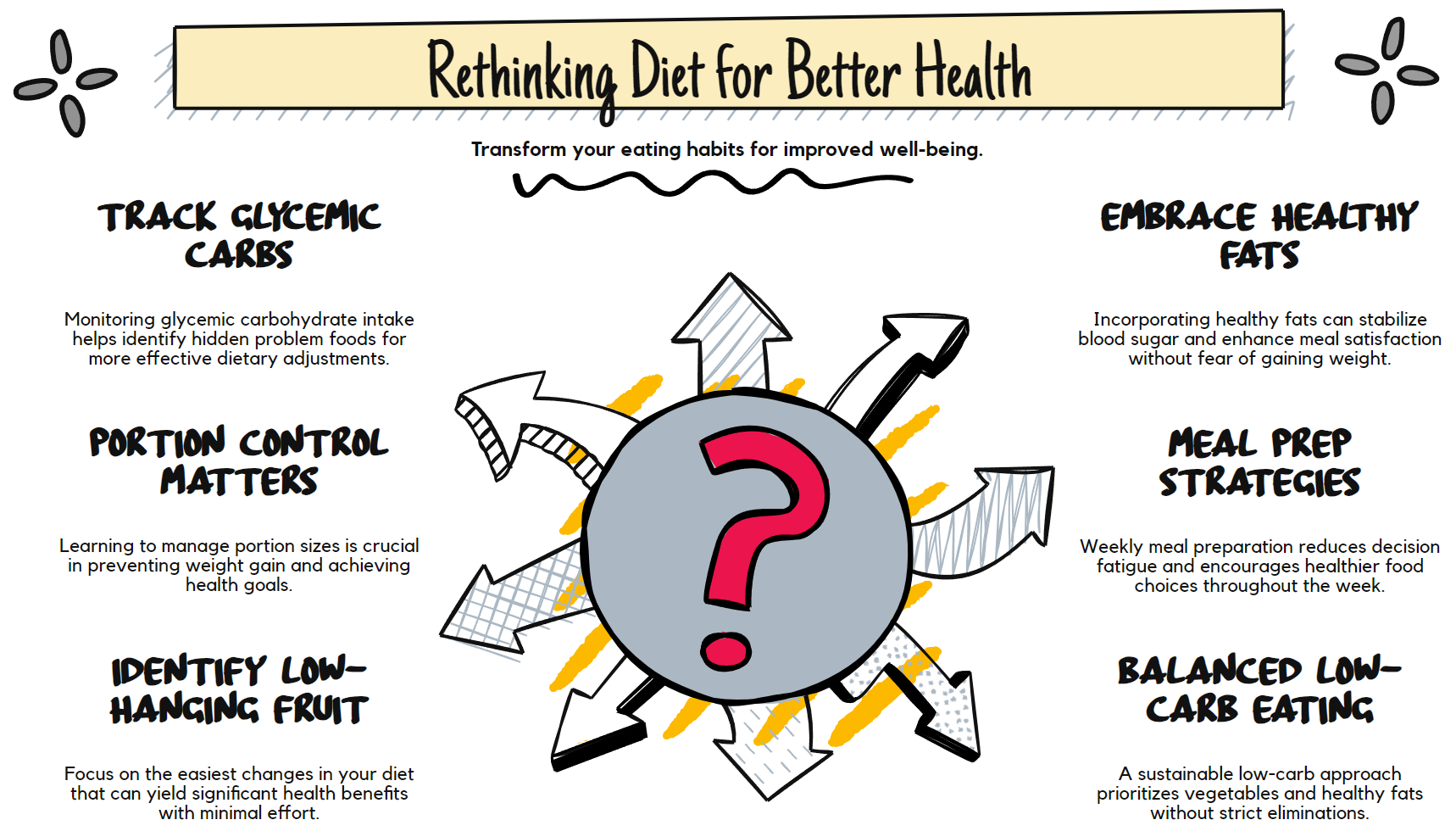
I Reversed Inflammation By Breaking All Diet Rules
I Reversed Inflammation By Breaking All Diet Rules
The blood test results in my hand felt like a personal failure. After years of religiously following the conventional wisdom of low-fat eating, my doctor delivered news I wasn't prepared for: insulin resistance and elevated markers of cardiovascular inflammation. How could this happen to someone who had avoided butter, bacon, and full-fat anything for decades?
That moment forced me to question everything I thought I knew about healthy eating. It launched me on a journey that would completely transform my approach to food and significantly improve my health markers. The path I discovered ran contrary to much of what I'd been taught about nutrition—and it might challenge your assumptions too.
The Fat Fear That Made Me Sick
Like many Americans, I spent years avoiding dietary fat as if it were poison. I dutifully chose skim milk, fat-free yogurt, and lean cuts of meat. I drizzled, never poured, olive oil. I checked labels for fat content before anything else.
Yet despite this vigilance, my weight crept up, my energy levels tanked, and eventually my bloodwork revealed the truth: this approach wasn't working for my body.
The first mental hurdle I needed to overcome was my deeply ingrained fear of fat. We've been conditioned to believe fat makes us fat, especially saturated fat. But my experience—and considerable research—suggests a more complex reality.
Now I no longer fear cheese or bacon. I don't scrutinize fat grams on labels. Instead, I focus on an entirely different nutritional component: glycemic carbohydrates.
Tracking What Actually Matters
The single most transformative habit I developed was tracking my glycemic carbohydrate intake for three weeks. Not forever—just long enough to develop awareness.
Remember those old Listerine commercials? "The taste you hate, once a day." That's how I describe carb tracking to skeptical friends. It's temporarily uncomfortable but incredibly revealing.
Most people who say they "avoid carbs" have no idea where all their carbs are actually coming from. I certainly didn't. Tracking exposed hidden carbs lurking in seemingly innocent foods—the milk in my coffee, the carrots in my "healthy" salad, the tomato sauce on my protein.
Those first weeks were eye-opening. I experienced initial weight loss and briefly felt the "keto flu" as my body adjusted to lower carb intake. But the clarity I gained about my actual food consumption was worth the temporary discomfort.
What's fascinating is how predictable our eating patterns really are. Most of us eat repetitively—the same breakfast, similar lunches, consistent snack choices. After tracking for just a couple of weeks, patterns emerged that showed me exactly where my problem foods were.
The Oil Switch That Changed Everything
One of my first practical changes involved cooking oils. While I'd always favored olive oil, I now primarily use avocado oil for cooking. It has a higher smoke point and neutral flavor that works well with most dishes.
I'm not fanatical about avoiding seed oils—a current dietary bogeyman—though I've naturally reduced them by cooking more at home. The bigger shift was in quantity rather than type: I no longer fear using adequate amounts of healthy oils in my cooking.
This oil abundance serves a purpose. Higher fat content in meals helps moderate blood sugar response and keeps me satisfied longer. The days of leaving the table hungry after a "healthy" low-fat meal are thankfully behind me.
Rethinking Protein and Portion Control
My relationship with protein, particularly red meat, remains complicated. I've found that even when eating low-carb, I gain weight with large portions of red meat. This discovery highlighted another critical factor in my dietary approach: portion control.
American portion sizes are simply too large. This becomes painfully obvious whenever I travel abroad. What passes for a "normal" restaurant serving here would often feed two people in many European countries.
I had to confront my own food addictions—both to sweets and to large portions. Even perfect food choices can lead to weight gain and inflammation when consumed in excessive amounts.
My strategy now involves simplicity and repetition. A typical dinner consists of a salmon fillet and a large salad. Yes, it's basic, but it's also sustainable and satisfying.
Creating a Sustainable Kitchen System
Weekly meal prep has become my secret weapon against decision fatigue and dietary slips. Every weekend, I prepare staples like roasted broccoli, Brussels sprouts, or cauliflower sautéed in avocado or olive oil, finished with a sprinkle of powdered Parmesan.
This approach might sound boring to culinary adventurers, but repetition serves a purpose. By reducing daily food decisions, I conserve willpower for the moments when it really matters—like business dinners or social events where low-inflammation choices are harder to find.
I've learned that successful dietary change isn't about motivation or willpower. It's about engineering your environment to make good choices easier than bad ones.
My refrigerator contains pre-washed salad greens, pre-cut vegetables, and proteins that can be quickly prepared. This removes friction from the process of assembling a low-inflammation meal, even when time and energy are in short supply.
Finding Your Low-Hanging Fruit
Changing everything at once rarely works for sustainable dietary change. Instead, I recommend identifying your "low-hanging fruit"—the highest-impact, lowest-effort changes you can make based on your current habits.
For many people, liquid carbs are the obvious first target. Sodas, juices, sweetened coffee drinks, and alcohol contribute significant glycemic load without providing satiety. They're also relatively easy to replace with zero-carb alternatives without feeling deprived.
For others, refined carbs like bread, pasta, and rice might be the first focus. These can often be reduced or replaced with lower-glycemic alternatives like cauliflower rice or zucchini noodles.
The key is identifying YOUR specific opportunities. This is why tracking, even temporarily, is so valuable. It creates a personalized map of your dietary landscape.
The Balanced Approach to Keto
When people hear I follow a lower-carb approach, they often jump to conclusions about "keto" eating. Many envision unlimited bacon and butter without vegetables.
The reality is more nuanced. My version of low-carb eating is vegetable-heavy, moderate in protein, and yes, generous with healthy fats. It's not about eliminating food groups but rather about understanding how different foods affect my body.
I eat berries occasionally. I enjoy dark chocolate. I don't panic if a sauce contains a small amount of sugar or flour. This flexibility makes the approach sustainable where strict elimination diets often fail.
The goal isn't dietary perfection but rather finding the sweet spot where inflammation is minimized without making eating a source of stress—which would ironically create more inflammation.
Beyond Food: The Complete Inflammation Picture
While my dietary approach has dramatically reduced my cardiovascular inflammation markers and reversed insulin resistance, food is only part of the equation. Sleep quality, stress management, and physical movement all play crucial roles in the inflammation puzzle.
A perfect diet cannot overcome chronic sleep deprivation or unmanaged stress. I've found that addressing these factors works synergistically with dietary changes to create comprehensive inflammation reduction.
Regular blood testing provides objective feedback on how these lifestyle factors are affecting my inflammation levels. Numbers don't lie, and seeing improvements in biomarkers provides powerful motivation to maintain these habits.
The Unexpected Mental Benefits
Perhaps the most surprising outcome of my dietary shift has been improved mental clarity and emotional stability. The blood sugar roller coaster I unknowingly rode for years affected not just my physical health but my cognitive function and mood as well.
With stable blood sugar and reduced inflammation comes consistent energy throughout the day, better focus, and fewer energy crashes. This cognitive benefit alone would make the dietary changes worthwhile, even without the cardiovascular improvements.
I've also freed myself from the moralization of food choices. Foods aren't "good" or "bad"—they're simply more or less aligned with my health goals. This mental shift has created a healthier relationship with eating itself.
Your Personal Inflammation Experiment
If you're intrigued by my experience, consider conducting your own three-week experiment. Track your glycemic carbohydrate intake honestly, aiming to stay under 50 grams daily. Note your energy levels, hunger patterns, and mood.
Pay attention to how you feel after different meals. Do certain foods leave you energized while others make you want to nap? These bodily signals provide valuable data about your personal inflammation triggers.
Remember that optimal eating patterns vary between individuals. My approach emphasizes finding YOUR best diet, not following someone else's rigid plan. The most effective anti-inflammation diet is one you can actually maintain long-term.
Breaking conventional dietary rules saved my cardiovascular health. Sometimes the most powerful thing we can do is question our most basic assumptions—especially when those assumptions aren't delivering the results we want. Your body's wisdom, once you learn to listen to it, may prove more valuable than any dietary dogma.
